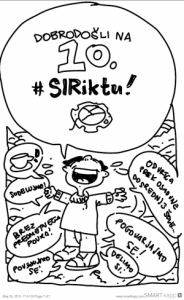Peter Grbec, Osnovna šola Antona Ukmarja Koper, Koper
I teach 20 eleven-year-old students Esperanto using English one hour a week in an elementary school with a tablet and the Duolingo app (https://www.duolingo.com/). Benefits? The mother tongue for the majority of students is Slovenian. When students learn Esperanto in English using Duolingo they must think in three different languages at the same time. Students now better understand how English works as before. Since Esperanto is completely correct (grammar comprises only 16 basic rules with no exceptions or irregular verbs) students better understand how work English and Slovenian. Students learn autonomously. Students must figure out by themselves the grammar rules from the excercises. As a teacher I help them only if they ask me. Students compete with each other (Duolingo allows students to monitor how many points achieve their friends). Duolingo also allows the teacher to create an online classroom where the teacher can follow the progress of the students It should be noted that students perceive Duolingo more as a game with points and competition with peers rather than learning (a) foreign language(s). Students learn without time and space limitations, since the majority of students learn Esperanto also at home by themselves using Duolingo.. Students think that they are not learning another uninteresting foreign language, but playing a new game on a tablet. After two months of learning, the students responded to a survey: 92% agreed or totally agreed that is funny learning Esperanto with the help of the tablet and Duolingo, 92% agreed or totally agreed that they prefer to learn Esperanto using Duolingo rather than using a textbook or workbook, 76% agreed or totally agreed that they would prefer to learn also other foreign languages using Duolingo, 84% agreed or totally agreed that now better understand English, What the students liked most (students were allowed to choose only one answer)? Most, 38% of students stated that they liked most that the teacher nothing explained and that they had to found out grammar rules by themselves, 23% stated that they liked most that the teacher helped only if they asked him, 15% stated that they liked most that they were continuously active and that they used a smart tablet. The main disadvantage of teaching national languages through Duolingo is that the national languages are incorrect and have a lot of exceptions so it is often difficult to figure out the grammatical rule. Therefore is recommended that the teacher first explains the grammar, and after that the students can make the exercises using Duolingo. After a half-year experience, I believe in the effectiveness of learning using Duolingo. This is also confirmed by a scientific study carried out in 2013. Some countries (Costarika and Guatemala) have begun teaching foreign languages using Duolingo as a pilot project in a number of public elementary schools. Duolingo is the also the most popular educational app on Google Play.
